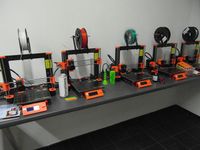3D Printers: Difference between revisions
m Add photo |
m →Cleanliness: linked isopropanol |
||
| Line 21: | Line 21: | ||
=== Cleanliness === | === Cleanliness === | ||
* for improved adhesion, remove any dust from the print bed and wipe it with a few drops of | * for improved adhesion, remove any dust from the print bed and wipe it with a few drops of [[isopropanol]] | ||
** | ** do '''not''' use [[acetone]] on the PEI sheet, it will destroy the print bed! | ||
* collect any clean plastic waste in the appropriate (material and color!) bags for recycling | * collect any clean plastic waste in the appropriate (material and color!) bags for recycling | ||
Revision as of 19:40, 5 November 2017
This article is mandatory reading for anyone who would like to 3D print, but it does not replace a personal introduction!
All of our printers use "fused filament fabrication" (FFF, a.k.a. FDM) and are therefore limited to thermoplastics as materials. Lots of cool things can be made with this technology, but it's good to be aware of the limits of FFF before starting to design your parts.

General Usage Guidelines
Slicing
- You can use Slic3r Prusa Edition with the default settings for the MK2 provided by Prusa Research.
Do Your Math
A few simple calculations will save you a lot time and material:
- shell thickness must be a multiple of the nozzle diameter
- elements very close to or below the nozzle diameter won't turn out well
- bottom/top thickness must be a multiple of your selected layer height
Supervision
- even simple prints can go wrong, so please watch the homing process and the first layer closely and check the progress regularly
- do not leave the printers unattended - you'll have to find someone else to supervise a print if you absolutely need to leave the building
- there is no need to sit in front of the machine all the time, just do not leave the Space!
Cleanliness
- for improved adhesion, remove any dust from the print bed and wipe it with a few drops of isopropanol
- do not use acetone on the PEI sheet, it will destroy the print bed!
- collect any clean plastic waste in the appropriate (material and color!) bags for recycling
SD Cards
- if you don't know a file, don't print it - ideally, slice all your models just before printing
File Storage
- always back up your files on your own storage, the SDs and the laptop might be cleaned up at any time without much warning!
- do not use old G-codes over and over again, but rather save your STLs and slice freshly for every print - there could have been changes to the machine since your last visit!
Pricing
We try to keep the price low to allow anyone to print. Apart from the material cost, we need new acetone from time to time. More costly is the time that needs to be put into repairing malfunctioning printers, plus possibly replacement parts. Usually we have more print requests than free functional printers. Please donate for these expenses:
- 5 ct/gram material cost
- + 1 € per hour of printing (first 30 minutes are free, 50 % off for members)
- + any additional amount you like
The higher priced long running prints could allow us to build more printers in the future. If you really cannot afford it, talk to us. We would like to support you in that case.
Changing filament requires an introduction and is different for each machine!
Tutors
If you're not sure about something, these Makers might be able to help: